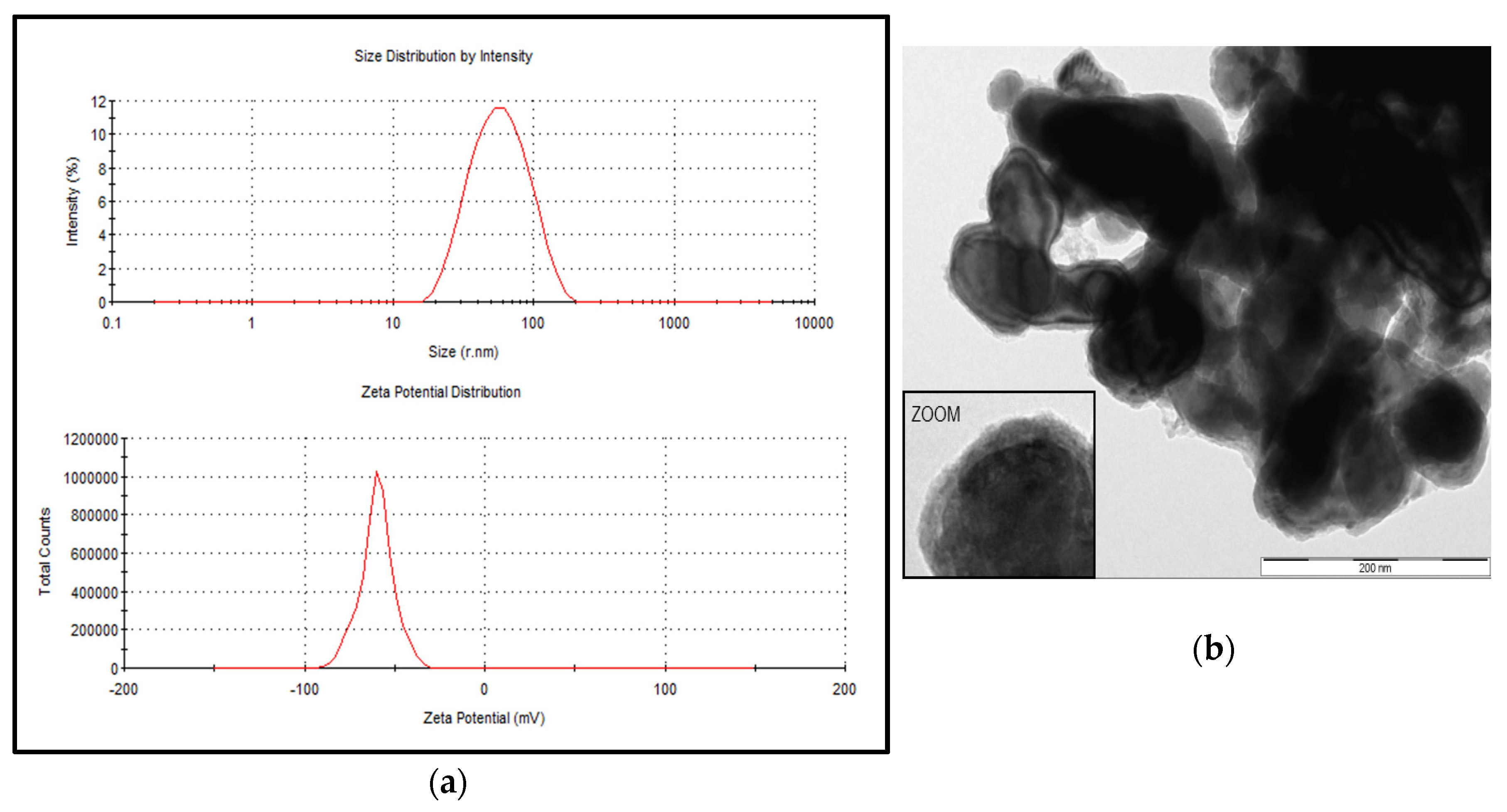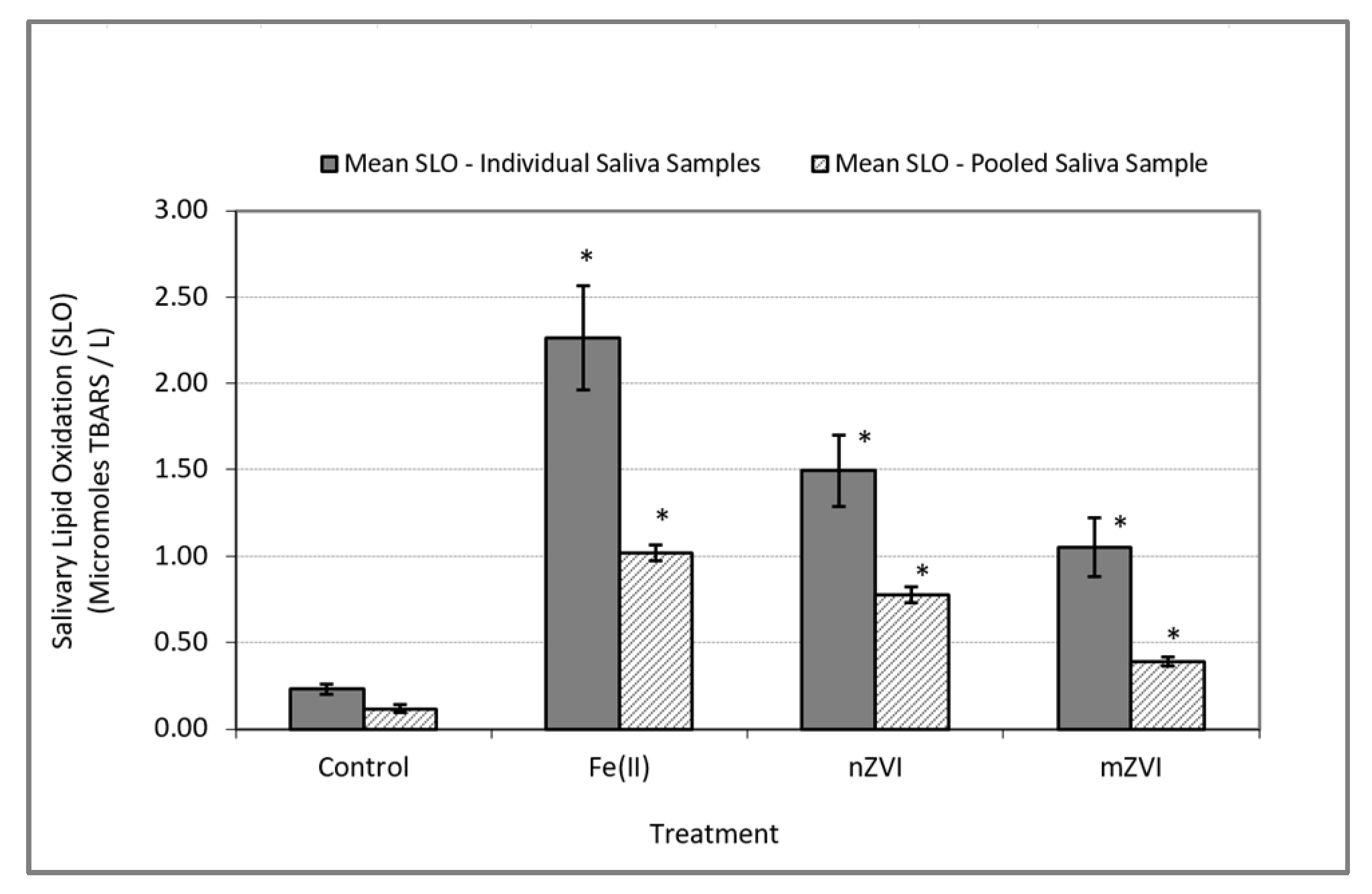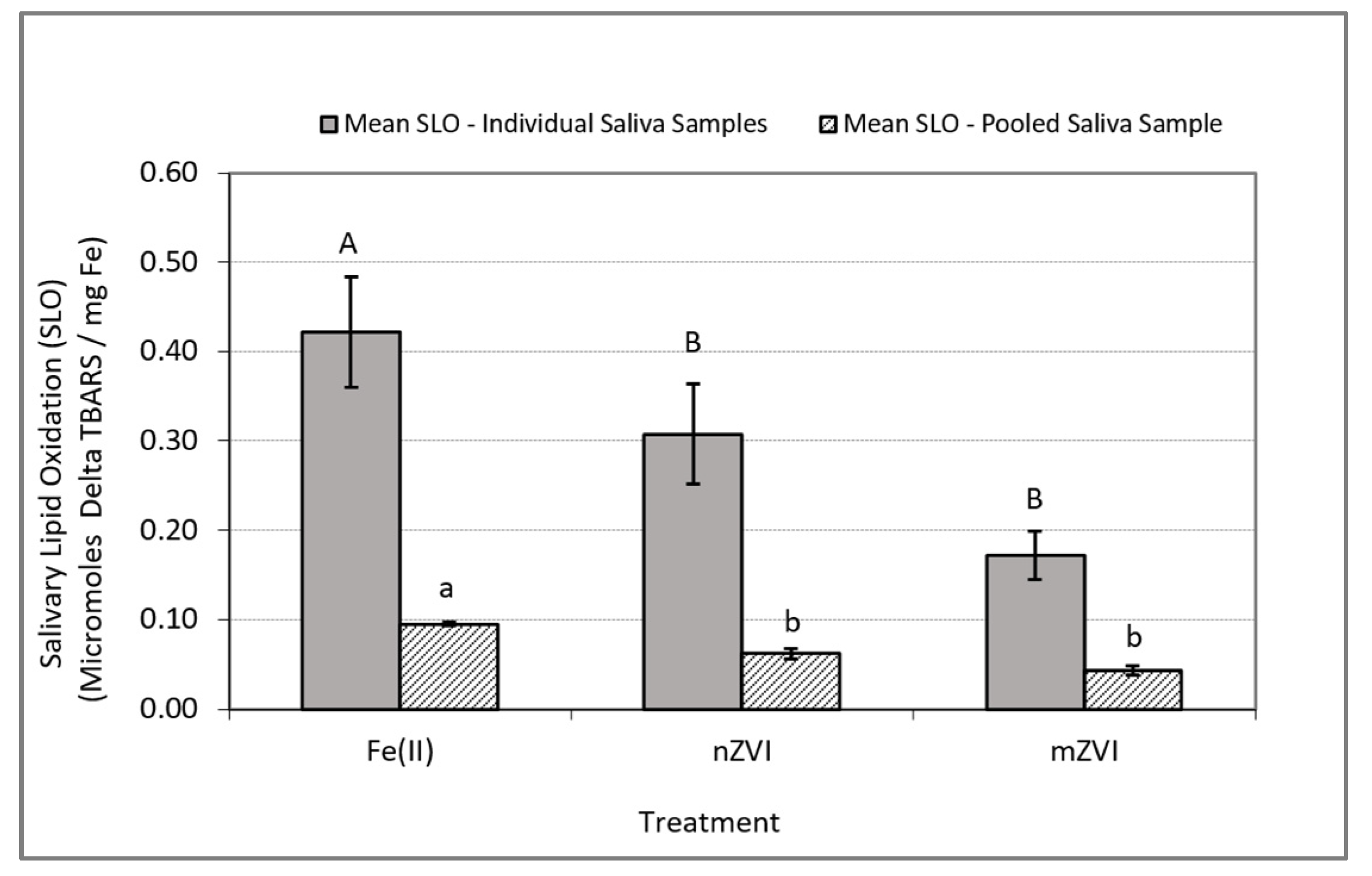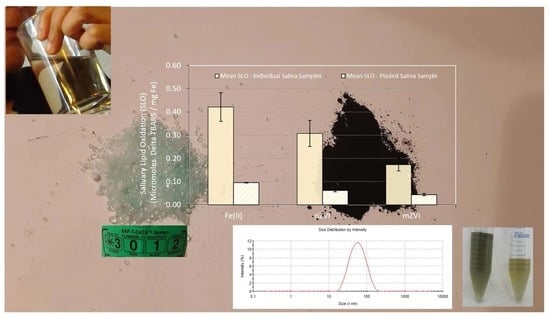In Vitro Evaluation of Iron-Induced Salivary Lipid Oxidation Associated with Exposure to Iron Nanoparticles: Application Possibilities and Limitations for Food and Exposure Sciences
Abstract
:1. Introduction
2. Materials and Methods
2.1. Human Subjects
2.2. Saliva Collection
2.3. Preparation of Iron Solutions
2.4. Zerovalent Iron Nanoparticles Characteristics
2.5. In Vitro Experiments
2.6. Data Analysis
3. Results
3.1. Particle Size and Zeta Potential Characteristics of the Nanoparticles
3.2. Measure of pH in Saliva and Test Samples
3.3. Iron-Induced Oxidative Stress Response
4. Discussion
4.1. Assessing the Impact of Nanoparticle Size and/or Aggregation on Iron-Induced Salivary Oxidative Stress Response
4.2. Exploring the Role of pH and Zeta Potential on Iron Nanoparticles Behavior in Salivary Fluid
4.3. Predicting Flavor Perception of Iron Nanoparticles Based on SLO Phenomenon
4.4. Potential Application of In Vitro SLO For Comparing Toxicity Of Metals and Their Associated Nanoparticles in Biological Fluids
5. Conclusions
Funding
Acknowledgments
Conflicts of Interest
References
- Gillham, R.W.; O’Hannesin, S.F. Enhanced Degradation of Halogenated Aliphatics by Zero-Valent Iron. Ground Water 1994, 32, 958–967. [Google Scholar] [CrossRef]
- Matheson, L.J.; Tratnyek, P.G. Reductive Dehalogenation of Chlorinated Methanes by Iron Metal. Environ. Sci. Technol. 1994, 28, 2045–2053. [Google Scholar] [CrossRef] [PubMed]
- USEPA. Nanotechnology for Site Remediation Fact Sheet; EPA 542-F-08-009; United States Environmental Protection Agency, Solid Waste and Emergency Response: Cincinnati, OH, USA, 2008. [Google Scholar]
- Cao, J.; Elliott, D.; Zhang, W.-X. Perchlorate Reduction by Nanoscale Iron Particles. J. Nanopart. Res. 2005, 7, 499–506. [Google Scholar] [CrossRef]
- Ghauch, A.; Tuqan, A.; Assi, H.A. Antibiotic removal from water: Elimination of amoxicillin and ampicillin by microscale and nanoscale iron particles. Environ. Pollut. 2009, 157, 1626–1635. [Google Scholar] [CrossRef] [PubMed]
- Hilty, F.M.; Arnold, M.; Hilbe, M.; Teleki, A.; Knijnenburg, J.T.; Ehrensperger, F.; Hurrell, R.F.; Pratsinis, S.E.; Langhans, W.; Zimmermann, M.B. Iron from nanocompounds containing iron and zinc is highly bioavailable in rats without tissue accumulation. Nat. Nanotechnol. 2010, 5, 374–380. [Google Scholar] [CrossRef] [PubMed]
- Tanboonchuy, V.; Hsu, J.-C.; Grisdnaurak, N.; Liao, C.-H. Impact of selected solution factors on arsenate and arsenite removal by nanoiron particles. Environ. Sci. Pollut. Res. 2011, 18, 857–864. [Google Scholar] [CrossRef]
- Reginatto, C.; Cecchin, I.; Heineck, K.S.; Thomé, A.; Reddy, K.R. Use of Nanoscale Zero-Valent Iron for Remediation of Clayey Soil Contaminated with Hexavalent Chromium: Batch and Column Tests. Int. J. Environ. Res. Public Heal. 2020, 17, 1001. [Google Scholar] [CrossRef] [Green Version]
- Arias, L.S.; Pessan, J.; Vieira, A.P.M.; Lima, T.; Delbem, A.C.B.; Monteiro, D.R. Iron Oxide Nanoparticles for Biomedical Applications: A Perspective on Synthesis, Drugs, Antimicrobial Activity, and Toxicity. Antibiotics 2018, 7, 46. [Google Scholar] [CrossRef] [Green Version]
- Shafiq, M.; Anjum, S.; Hano, C.; Anjum, I.; Abbasi, B.H. An Overview of the Applications of Nanomaterials and Nanodevices in the Food Industry. Foods 2020, 9, 148. [Google Scholar] [CrossRef] [Green Version]
- Garcia-Fernandez, J.; Turiel, D.; Bettmer, J.; Jakubowski, N.; Panne, U.; García, L.R.; Llopis, J.; González, C.S.; Montes-Bayon, M. In Vitro and in situ experiments to evaluate the biodistribution and cellular toxicity of ultrasmall iron oxide nanoparticles potentially used as oral iron supplements. Nanotoxicology 2020, 14, 388–403. [Google Scholar] [CrossRef]
- Sohn, K.; Kang, S.W.; Ahn, S.; Woo, M.; Yang, S.-K. Fe(0) Nanoparticles for Nitrate Reduction: Stability, Reactivity, and Transformation. Environ. Sci. Technol. 2006, 40, 5514–5519. [Google Scholar] [CrossRef] [PubMed]
- Wigginton, N.; Haus, K.L.; Hochella, M.F., Jr. Aquatic environmental nanoparticles. J. Environ. Monit. 2007, 9, 1306. [Google Scholar] [CrossRef]
- Rudramurthy, G.R.; Swamy, M.K. Potential applications of engineered nanoparticles in medicine and biology: An update. JBIC J. Biol. Inorg. Chem. 2018, 23, 1185–1204. [Google Scholar] [CrossRef] [PubMed]
- Keenan, C.R.; Goth-Goldstein, R.; Lucas, N.; Sedlak, D.L. Oxidative Stress Induced by Zero-Valent Iron Nanoparticles and Fe(II) in Human Bronchial Epithelial Cells. Environ. Sci. Technol. 2009, 43, 4555–4560. [Google Scholar] [CrossRef] [PubMed]
- Guo, B.; Zebda, R.; Drake, S.J.; Sayes, C.M. Synergistic effect of co-exposure to carbon black and Fe2O3 nanoparticles on oxidative stress in cultured lung epithelial cells. Part. Fibre Toxicol. 2009, 6, 4. [Google Scholar] [CrossRef] [PubMed] [Green Version]
- Shi, Z.; Woodhouse, M.T.; Carslaw, K.S.; Krom, M.D.; Mann, G.W.; Baker, A.R.; Savov, I.; Fones, G.R.; Brooks, B.; Drake, N.; et al. Minor effect of physical size sorting on iron solubility of transported mineral dust. Atmos. Chem. Phys. Discuss. 2011, 11, 8459–8469. [Google Scholar] [CrossRef] [Green Version]
- Hochella, M.F.; Kasama, T.; Putnis, A.; Moore, J.N. Environmentally important, poorly crystalline Fe/Mn hydrous oxides: Ferrihydrite and a possibly new vernadite-like mineral from the Clark Fork River Superfund Complex. Am. Miner. 2005, 90, 718–724. [Google Scholar] [CrossRef]
- Rabajczyk, A.; Namiesnik, J. Speciation of iron in the aquatic environment. Water Environ. Res. 2014, 86, 741–758. [Google Scholar] [CrossRef]
- Jang, M.-H.; Lim, M.; Hwang, Y.S. Potential environmental implications of nanoscale zero-valent iron particles for environmental remediation. Environ. Health. Toxicol. 2014, 29, e2014022. [Google Scholar] [CrossRef] [Green Version]
- Bhuvaneshwari, M.; Kumar, D.; Roy, R.; Chakraborty, S.; Parashar, A.; Mukherjee, A.; Chandrasekaran, N.; Mukherjee, A. Toxicity, accumulation, and trophic transfer of chemically and biologically synthesized nano zero valent iron in a two species freshwater food chain. Aquat. Toxicol. 2017, 183, 63–75. [Google Scholar] [CrossRef]
- Zhao, D.; Chenab, C.; Sheng, G.; Wang, X. Effect of environmental conditions on the retention behaviour of Pb(II) by hematite. J. Chem. Technol. Biotechnol. 2011, 86, 1099–1106. [Google Scholar] [CrossRef]
- Ďuračková, Z. Some current insights into oxidative stress. Physiol. Res. 2009, 59, 459–469. [Google Scholar] [PubMed]
- Bondy, S.C. Nanoparticles and Colloids as Contributing Factors in Neurodegenerative Disease. Int. J. Environ. Res. Public Health 2011, 8, 2200–2211. [Google Scholar] [CrossRef] [PubMed]
- Palombella, S.; Pirrone, C.; Rossi, F.; Armenia, I.; Cherubino, M.; Valdatta, L.; Raspanti, M.; Bernardini, G.; Gornati, R. Effects of Metal Micro and Nano-Particles on hASCs: An In Vitro Model. Nanomaterials 2017, 7, 212. [Google Scholar] [CrossRef]
- Yagi, K. Simple Assay for the Level of Total Lipid Peroxides in Serum or Plasma. Free Radic. Antioxid. Protoc. 2003, 108, 101–106. [Google Scholar] [CrossRef]
- Ömur-Özbek, P. Macromolecular Reactions and Sensory Perceptions at the Air-Water-Human Interface. Ph.D. Thesis, Virginia Polytechnic Institute and State University, Blacksburg, VA, USA, 2008. [Google Scholar]
- Barranco, T.; Rubio, C.P.; Tvarijonaviciute, A.; Rubio, M.; Damia, E.; Lamy, E.; Cugat, R.; Cerón, J.J.; Tecles, F.; Escribano, D. Changes of salivary biomarkers under different storage conditions: Effects of temperature and length of storage. Biochem. Medica 2019, 29, 94–111. [Google Scholar] [CrossRef] [Green Version]
- Eaton, A.D.; American Public Health Association (APHA); The American Water Works Association (AWWA); Water Environment Federation (WEF). Standard Methods for Examination of Water and Wastewater; APHA-AWWA-WEF: Washington, DC, USA, 2005. [Google Scholar]
- Mirlohi, S.; Dietrich, A.M.; Duncan, S.E. Age-Associated Variation in Sensory Perception of Iron in Drinking Water and the Potential for Overexposure in the Human Population. Environ. Sci. Technol. 2011, 45, 6575–6583. [Google Scholar] [CrossRef]
- Ömür-Özbek, P.; Dietrich, A.M.; Duncan, S.E.; Lee, Y. Role of Lipid Oxidation, Chelating Agents, and Antioxidants in Metallic Flavor Development in the Oral Cavity. J. Agric. Food Chem. 2012, 60, 2274–2280. [Google Scholar] [CrossRef]
- Aquafina Products Water Quality Report. Available online: https://www.aquafina.com/pdf/bottledWaterInformation_en.pdf (accessed on 12 May 2020).
- Spanier, A.M.; Traylor, R.D. A Rapid, Direct Chemical Assay for the Quantitative Determination of Thiobarbituric Acid Reactive Substances in Raw, Cooked, and Cooked/Stored Muscle Foods. J. Muscle Foods 1991, 2, 165–176. [Google Scholar] [CrossRef]
- Wang, H.; Virginia Polytechnic Institute and State University, Blacksburg, VA, USA. Determination of Thiobarbituric acid Reactive Substances (TBARS) for Water Base Liquid Food with Low Oxidation. 2009; Unpublished work. [Google Scholar]
- Nanorion Future Techology. Zeriovalent Iron Nanoparticles (NZVI). Available online: https://nanoiron.cz/en/products/zero-valent-iron-nanoparticles/nanofer-star (accessed on 19 May 2020).
- Karlsson, H.L.; Gustafsson, J.; Cronholm, P.; Möller, L. Size-dependent toxicity of metal oxide particles—A comparison between nano- and micrometer size. Toxicol. Lett. 2009, 188, 112–118. [Google Scholar] [CrossRef]
- Kim, J.Y.; Lee, C.; Love, D.C.; Sedlak, D.L.; Yoon, J.; Nelson, K.L. Inactivation of MS2 Coliphage by Ferrous Ion and Zero-Valent Iron Nanoparticles. Environ. Sci. Technol. 2011, 45, 6978–6984. [Google Scholar] [CrossRef] [PubMed]
- Phenrat, T.; Long, T.C.; Lowry, G.V.; Veronesi, B. Partial Oxidation (“Aging”) and Surface Modification Decrease the Toxicity of Nanosized Zerovalent Iron. Environ. Sci. Technol. 2009, 43, 195–200. [Google Scholar] [CrossRef] [PubMed]
- Zetasizer Nanoseries Technical Notes. Zeta Potential: An Introduction in 30 Minutes. Available online: https://www.malvernpanalytical.com/en/learn/knowledge-center/technical-notes/TN101104ZetaPotentialIntroduction (accessed on 23 March 2020).
- Phenrat, T.; Saleh, N.; Sirk, K.; Kim, H.-J.; Tilton, R.D.; Lowry, G.V. Stabilization of aqueous nanoscale zerovalent iron dispersions by anionic polyelectrolytes: Adsorbed anionic polyelectrolyte layer properties and their effect on aggregation and sedimentation. J. Nanopart. Res. 2007, 10, 795–814. [Google Scholar] [CrossRef]
- Tratnyek, P.G.; Johnson, R.L. Nanotechnologies for environmental cleanup. Nano Today 2006, 1, 44–48. [Google Scholar] [CrossRef]
- Zhang, W.-X.; Elliott, D.W. Applications of iron nanoparticles for groundwater remediation. Remediat. J. 2006, 16, 7–21. [Google Scholar] [CrossRef]
- Saleh, N.; Kim, H.-J.; Phenrat, T.; Matyjaszewski, K.; Tilton, R.D.; Lowry, G.V. Ionic Strength and Composition Affect the Mobility of Surface-Modified Fe0Nanoparticles in Water-Saturated Sand Columns. Environ. Sci. Technol. 2008, 42, 3349–3355. [Google Scholar] [CrossRef]
- Tenovuo, J.O. Human Saliva: Clinical Chemistry and Microbiology; CRC Press: Boca Raton, FL, USA, 1989; Volume I, p. 205. [Google Scholar]
- Rykke, M.; Young, A.; Smistad, G.; Rölla, G.; Karlsen, J. Zeta potentials of human salivary micelle-like particles. Colloids Surf. B Biointerfaces 1996, 6, 51–56. [Google Scholar] [CrossRef]
- Teubl, B.J.; Stojkovic, B.; Docter, D.; Pritz, E.; Leitinger, G.; Poberaj, I.; Prassl, R.; Stauber, R.H.; Fröhlich, E.; Khinast, J.G.; et al. The effect of saliva on the fate of nanoparticles. Clin. Oral Investig. 2017, 22, 929–940. [Google Scholar] [CrossRef]
- Çelebioğlu, H.Y.; Lee, S.; Chronakis, I.S. Interactions of salivary mucins and saliva with food proteins: A review. Crit. Rev. Food Sci. Nutr. 2019, 60, 1–20. [Google Scholar] [CrossRef] [Green Version]
- Hong, J. Descriptive sensory analysis of copper and iron compounds in water in comparison with psychophysical measurement. Food Sci. Biotechnol. 2011, 20, 987–995. [Google Scholar] [CrossRef]
- Omur-Ozbek, P.; Dietrich, A.M. Retronasal perception and flavour thresholds of iron and copper in drinking water. J. Water Health 2011, 9, 1–9. [Google Scholar] [CrossRef] [PubMed]
- Tamura, T.; Taniguchi, K.; Suzuki, Y.; Okubo, T.; Takata, R.; Konno, T. Iron Is an Essential Cause of Fishy Aftertaste Formation in Wine and Seafood Pairing. J. Agric. Food Chem. 2009, 57, 8550–8556. [Google Scholar] [CrossRef] [PubMed]
- Lawless, H.T.; Schlake, S.; Smythe, J.; Lim, J.; Yang, H.; Chapman, K.; Bolton, B. Metallic taste and retronasal smell. Chem. Senses 2004, 29, 25–33. [Google Scholar] [CrossRef] [PubMed] [Green Version]
- Lim, J.; Lawless, H.T. Oral sensations from iron and copper sulfate. Physiol. Behav. 2005, 85, 308–313. [Google Scholar] [CrossRef] [PubMed]
- Zimmermann, M.; Hilty, F.M. Nanocompounds of iron and zinc: Their potential in nutrition. Nanoscale 2011, 3, 2390. [Google Scholar] [CrossRef] [PubMed]
- Brewer, G.J. Risks of Copper and Iron Toxicity during Aging in Humans. Chem. Res. Toxicol. 2010, 23, 319–326. [Google Scholar] [CrossRef]
- Sahu, S.C.; Casciano, D.A. Nanotoxicity: From In Vivo to In Vitro Models to Health Risks; John Wiley & Sons, Ltd.: West Sussex, UK, 2009. [Google Scholar]
- Shibamoto, T. Analytical methods for trace levels of reactive carbonyl compounds formed in lipid peroxidation systems. J. Pharm. Biomed. Anal. 2006, 41, 12–25. [Google Scholar] [CrossRef]
- Moore, K.; Roberts, L.J. Measurement of lipid peroxidation. Free. Radic. Res. 1998, 28, 659–671. [Google Scholar] [CrossRef]
- Dotan, Y. Lipid peroxidation cannot be used as a universal criterion of oxidative stress. Prog. Lipid Res. 2004, 43, 200–227. [Google Scholar] [CrossRef]
- Dalle-Donne, I.; Rossi, R.; Colombo, R.; Giustarini, D.; Milzani, A.D.G. Biomarkers of Oxidative Damage in Human Disease. Clin. Chem. 2006, 52, 601–623. [Google Scholar] [CrossRef]
- Catala, A. Lipid peroxidation of membrane phospholipids generates hydroxy-alkenals and oxidized phospholipids active in physiological and/or pathological conditions. Chem. Phys. Lipids 2009, 157, 1–11. [Google Scholar] [CrossRef] [PubMed]
- Semerád, J.; Moeder, M.; Filip, J.; Pivokonský, M.; Filipová, A.; Cajthaml, T. Oxidative stress in microbes after exposure to iron nanoparticles: Analysis of aldehydes as oxidative damage products of lipids and proteins. Environ. Sci. Pollut. Res. 2019, 26, 33670–33682. [Google Scholar] [CrossRef] [PubMed]
- Miller, D.D. Food nanotechnology: New leverage against iron deficiency. Nat. Nanotechnol. 2010, 5, 318–319. [Google Scholar] [CrossRef] [PubMed]
- WHO. The Global Prevalence of Anemia in 2011. World Health Organization (WHO), 2015. Available online: https://www.who.int/nutrition/publications/micronutrients/global_prevalence_anaemia_2011/en/ (accessed on 19 May 2020).



| Treatment | Mean SLO (μM TBARS) * | SEM 2 [95% Confidence Interval] | Delta SLO 3 (μM TBARS/mg Fe) | SEM [95% Confidence Interval] |
|---|---|---|---|---|
| Control | 0.229 (SD 1 = 0.098) | 0.031 [0.159–0.299] | - | - |
| Fe(II) | 2.26 (SD 1 = 0.959) | 0.303 [1.578–2.95] | 0.421 (SD 1 = 0.195) | 0.062 [0.282–0.561] |
| nZVI | 1.49 (SD 1 = 0.751) | 0.208 [1.023–1.97] | 0.307 (SD 1 = 0.202) | 0.056 [0.181–0.434] |
| mZVI | 1.05 (SD 1 = 0.620) | 0.172 [0.662–1.44] | 0.172 (SD 1 = 0.096) | 0.027 [0.112–0.232] |
| Treatment | Mean SLO (μM TBARS) | SEM 2 [95% Confidence Interval] | Delta SLO 3 (μM TBARS/mg Fe) | SEM [95% Confidence Interval] |
|---|---|---|---|---|
| Control | 0.117 (SD 1 = 0.041) | 0.023 [0.016–0.218] | - | - |
| Fe(II) | 1.020 (SD = 0.077) | 0.045 [0.828–1.212] | 0.095 (SD = 0.003) | 0.002 [0.092–0.098] |
| nZVI | 0.777 (SD = 0.080) | 0.046 [0.577–0.977] | 0.062 (SD = 0.010) | 0.006 [0.052–0.072] |
| mZVI | 0.389 (SD = 0.044) | 0.025 [0.280–0.498] | 0.043 (SD = 0.008) | 0.005 [0.035–0.052] |
© 2020 by the author. Licensee MDPI, Basel, Switzerland. This article is an open access article distributed under the terms and conditions of the Creative Commons Attribution (CC BY) license (http://creativecommons.org/licenses/by/4.0/).
Share and Cite
Mirlohi, S. In Vitro Evaluation of Iron-Induced Salivary Lipid Oxidation Associated with Exposure to Iron Nanoparticles: Application Possibilities and Limitations for Food and Exposure Sciences. Int. J. Environ. Res. Public Health 2020, 17, 3622. https://doi.org/10.3390/ijerph17103622
Mirlohi S. In Vitro Evaluation of Iron-Induced Salivary Lipid Oxidation Associated with Exposure to Iron Nanoparticles: Application Possibilities and Limitations for Food and Exposure Sciences. International Journal of Environmental Research and Public Health. 2020; 17(10):3622. https://doi.org/10.3390/ijerph17103622
Chicago/Turabian StyleMirlohi, Susan. 2020. "In Vitro Evaluation of Iron-Induced Salivary Lipid Oxidation Associated with Exposure to Iron Nanoparticles: Application Possibilities and Limitations for Food and Exposure Sciences" International Journal of Environmental Research and Public Health 17, no. 10: 3622. https://doi.org/10.3390/ijerph17103622





